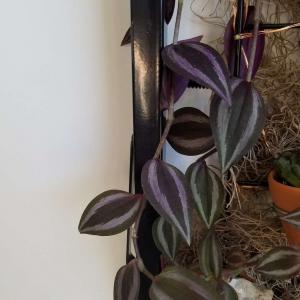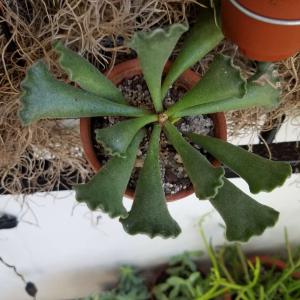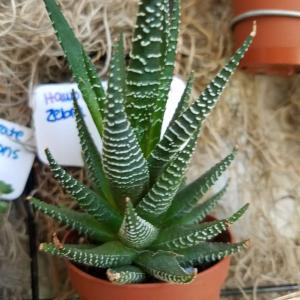成长记
Llamadrama
2017年11月12日

I now added "Tradescantia fluminesis - Wandering Jew or Inch Plant" in my "garden"


1
1
成长记
Llamadrama
2017年11月12日

I now added "Adromischus cristatus - Crinkle Leaf Plant" in my "garden"


0
0
成长记
Llamadrama
2017年11月12日

I now added "Rhoeo spathacea 'Tricolor' - Oyster Plant or Moses-In-The-Cradle" in my "garden"


0
0
成长记
Llamadrama
2017年11月12日

I now added "Graptopetalum paraguayense - Ghost Plant" in my "garden"


0
0
成长记
Llamadrama
2017年11月12日

I now added "Aptenia cordifolia variegata - Variegated Heartleaf Ice Plant" in my "garden"


0
1
成长记
Llamadrama
2017年11月12日

I now added "Gymnostachyum verschaffeltii
and Pilea involucrate
- Nerve Plant and
Friendship Plant" in my "garden"

and Pilea involucrate
- Nerve Plant and
Friendship Plant" in my "garden"

1
0
文章
Miss Chen
2017年11月12日

When deciding a new plant to grow in Georgia, a blueberry bush is a GREAT choice. The are easy to maintain, don't have thorns and won't spread like crazy growing all over the place.

Recently, doctors have started saying that blueberries are among the top most beneficial fruits to feed your body. It's no wonder, considering they yield the highest antioxidant capacity of all fresh fruit, neutralize free radicals and aid in reducing belly fat. Not to mention they help promote urinary tract health, brain health, help to fight heart disease and help relieve constipation and digestion. Some doctors even suspect they are linked with reversing cancer!
If you live in Georgia, you are exceptionally lucky as you live in the perfect climate for growing blueberries. It's in the south so it makes growing them much easier as the summers are long and hot and there is usually very little cold. It's the perfect climate to grow blue berries, in Georgia!
So how do you do it? The following three simple steps will show you.
Step 1
Choose the right variety of blueberry bush! Get the rabbiteye blueberry bushes as they are best for the climate in the south. If you want to grow blueberries in Georgia, it is critical you choose the rabbiteye variety for the most success. There are three different varieties of blueberries, such as highbush, lowbush and rabbiteye. The highbush and lowbush are more geared toward climates other than the kind in Georgia, so you will want to steer away from them.
Rabbiteye blue berries require more heat which makes them perfect for growing in Georgia. Another reason you will want to plant rabbiteye blueberry bushes is because they tend to grow the biggest at a whopping 10 feet high! That means more blueberries for your money and more bang for your buck.
Where do you get rabbiteye blueberry bushes? Most local nurseries in Georgia carry them, but if you have any trouble finding them you can always order them online for fairly cheap.
When you buy them, try to get plants that 2 years old as it will drastically speed up the production of blueberries.

Step 2
Plant them correctly. They are self fertile, but for the best results plant them near two other varieties to create cross pollination.
For the best development possible of rabbiteye blueberries bushes, plant them in the absolute sunniest place possible and in a region where they won't be crippled by late spring frosts.
Make sure you plant them in an acidic soil of anywhere between 4.5 pH and 4.8 pH, as this is what they will need to grow and meet their full potential. Most soils aren't this acidic, naturally, so be sure to do a bit of soil testing to make sure you select the most acidic and fertile spot.
You can buy home soil test kits either at the nursery where you buy the plant. If you can't find them in your local nursery, feel free to order your soil test kit online as well. If the soil in the area has too high of a pH balance, be sure to acidify it with Mir-Acid. You can buy Mir-Acid at just about any nursery nationwide.
To make the soil more fertile for the growth of your blueberries, be sure to add compost to the soil.
Once you make sure the soil is both fertile and of the right acidity, begin to plant your blueberry bushes by spacing them approximately four feet away from each other.
Be sure to plant the blueberry bushes so that their bloom periods overlap. For example, you want to have one mid season and one getting ready to start it's bloom period. This will ensure you will have blue berries year round.
I recommended applying a wood chip mulch around your blueberry plant to discourage the growth of weeds.
Step 3
Maintain them correctly. There are quite a few important things you need to do to make sure that your blueberries production is maintained. One of these things is to test the pH balance of the soil annually to make sure that it hasn't changed. After your blueberry bushes have been in production for a few years, you will want to prune them to open the way for new growth.
You'll need a good strategy to keep the birds away, unless you don't mind having the birds raid your plants. If you don't want to share the blueberries with the birds, then you're going to want to cover the bushes with a net.
To determine when the berries are ripe and ready for eating, hold your hand beneath each clump and gently brush them with your fingers. Any berries that are ready to be eaten will easily fall into your hand. Enjoy!

Recently, doctors have started saying that blueberries are among the top most beneficial fruits to feed your body. It's no wonder, considering they yield the highest antioxidant capacity of all fresh fruit, neutralize free radicals and aid in reducing belly fat. Not to mention they help promote urinary tract health, brain health, help to fight heart disease and help relieve constipation and digestion. Some doctors even suspect they are linked with reversing cancer!
If you live in Georgia, you are exceptionally lucky as you live in the perfect climate for growing blueberries. It's in the south so it makes growing them much easier as the summers are long and hot and there is usually very little cold. It's the perfect climate to grow blue berries, in Georgia!
So how do you do it? The following three simple steps will show you.
Step 1
Choose the right variety of blueberry bush! Get the rabbiteye blueberry bushes as they are best for the climate in the south. If you want to grow blueberries in Georgia, it is critical you choose the rabbiteye variety for the most success. There are three different varieties of blueberries, such as highbush, lowbush and rabbiteye. The highbush and lowbush are more geared toward climates other than the kind in Georgia, so you will want to steer away from them.
Rabbiteye blue berries require more heat which makes them perfect for growing in Georgia. Another reason you will want to plant rabbiteye blueberry bushes is because they tend to grow the biggest at a whopping 10 feet high! That means more blueberries for your money and more bang for your buck.
Where do you get rabbiteye blueberry bushes? Most local nurseries in Georgia carry them, but if you have any trouble finding them you can always order them online for fairly cheap.
When you buy them, try to get plants that 2 years old as it will drastically speed up the production of blueberries.

Step 2
Plant them correctly. They are self fertile, but for the best results plant them near two other varieties to create cross pollination.
For the best development possible of rabbiteye blueberries bushes, plant them in the absolute sunniest place possible and in a region where they won't be crippled by late spring frosts.
Make sure you plant them in an acidic soil of anywhere between 4.5 pH and 4.8 pH, as this is what they will need to grow and meet their full potential. Most soils aren't this acidic, naturally, so be sure to do a bit of soil testing to make sure you select the most acidic and fertile spot.
You can buy home soil test kits either at the nursery where you buy the plant. If you can't find them in your local nursery, feel free to order your soil test kit online as well. If the soil in the area has too high of a pH balance, be sure to acidify it with Mir-Acid. You can buy Mir-Acid at just about any nursery nationwide.
To make the soil more fertile for the growth of your blueberries, be sure to add compost to the soil.
Once you make sure the soil is both fertile and of the right acidity, begin to plant your blueberry bushes by spacing them approximately four feet away from each other.
Be sure to plant the blueberry bushes so that their bloom periods overlap. For example, you want to have one mid season and one getting ready to start it's bloom period. This will ensure you will have blue berries year round.
I recommended applying a wood chip mulch around your blueberry plant to discourage the growth of weeds.
Step 3
Maintain them correctly. There are quite a few important things you need to do to make sure that your blueberries production is maintained. One of these things is to test the pH balance of the soil annually to make sure that it hasn't changed. After your blueberry bushes have been in production for a few years, you will want to prune them to open the way for new growth.
You'll need a good strategy to keep the birds away, unless you don't mind having the birds raid your plants. If you don't want to share the blueberries with the birds, then you're going to want to cover the bushes with a net.
To determine when the berries are ripe and ready for eating, hold your hand beneath each clump and gently brush them with your fingers. Any berries that are ready to be eaten will easily fall into your hand. Enjoy!
0
0
文章
Miss Chen
2017年11月12日

Blueberry plants are simple fruits to for almost anyone to grow. They grow in a variety of regions and will regrow year after year. A single blueberry plant can produce up to eight bushels of blueberries in a single growing season. Blueberries grow best in areas with acidic soil, so if your region has an abundance of acidity, you are in an even more ideal position to grow blueberries at home.

Step 1
Wait until the threat of frost subsides in the early spring to plant blueberry bushes.
Step 2
Plan blueberry bush plantings in a location that receives at least four to five hours of sunlight per day.
Step 3
Dig a space measuring 4 feet wide by 2 feet deep in which to grow each blueberry plant. Space the blueberry plants 6 feet apart since full grown plants will bush out quite a bit.
Step 4
Pour a thick layer of peat moss into the bottom of the hole and then insert the blueberry bush on top of it. Use your hands to pack the soil around the base of the blueberry plant to completely cover the roots.

Step 5
Trim away the lower branches of the blueberry plant to prevent them touching the ground.
Step 6
Apply fertilizer to the blueberry plant after it has been planted for several months. Use a 10-10-10 fertilizer and spread it in a 12-inch diameter around the base of the blueberry plant.
Step 7
Water the blueberry plants at least twice per week and more during periods of drought.

Step 1
Wait until the threat of frost subsides in the early spring to plant blueberry bushes.
Step 2
Plan blueberry bush plantings in a location that receives at least four to five hours of sunlight per day.
Step 3
Dig a space measuring 4 feet wide by 2 feet deep in which to grow each blueberry plant. Space the blueberry plants 6 feet apart since full grown plants will bush out quite a bit.
Step 4
Pour a thick layer of peat moss into the bottom of the hole and then insert the blueberry bush on top of it. Use your hands to pack the soil around the base of the blueberry plant to completely cover the roots.

Step 5
Trim away the lower branches of the blueberry plant to prevent them touching the ground.
Step 6
Apply fertilizer to the blueberry plant after it has been planted for several months. Use a 10-10-10 fertilizer and spread it in a 12-inch diameter around the base of the blueberry plant.
Step 7
Water the blueberry plants at least twice per week and more during periods of drought.
0
0













